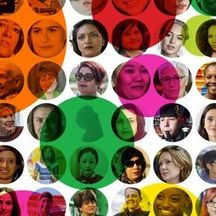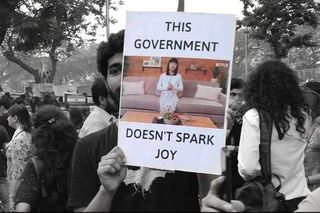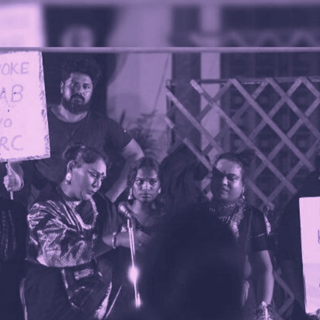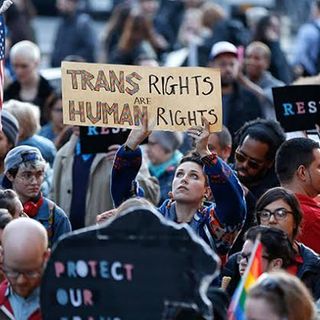
How Anti‑NRC‑CAA Humor Can Work as a Tool of Political Resistance
Using humor to ridicule authority is a non-violent means of political expression and mass mobilization.

“Merry Crisis and a Happy New Fear,” read numerous protest signs wielded by dissenters at anti-CAA-NRC protests across India. Heralding a new year amidst severe political oppression, police brutality and the threat of disenfranchisement of most minority groups in India due to revised citizenship requirements announced by the Modi-government, protesters have often adopted a wry, sardonic tone on social media, protest posters and slogans to mock the government and express their dissent.
The National Register of Citizens (NRC) is an exercise that will require Indian citizens to prove their or their family’s citizenship going as far back as 1971 through documents, and the Citizenship Amendment Act (CAA) is a recent law that, in effect, bans Muslim migrants from neighboring Islamic countries such as Pakistan, Bangladesh, and Afghanistan. Combined, the NRC-CAA has been interpreted as a threat to many minorities residing in India as well, with the power to render them stateless and sent to detention centers.
Protesters want to “Omit Shah” (a pun on Indian Home Minister Amit Shah’s name), “triple-talaq” the government (the current government recently banned the Islamic tradition), and now have flipped the “OK Boomer” trend to fit supporters of the Sangh Parivar (an umbrella term for Hindu nationalist organizations) with “OK Sanghi.” This manner of dissent — seemingly light-hearted but part of a greater movement to revoke the CAA and stop the government from enforcing the NRC — has the power to make accessible political ideas or opinions, which can help further build a sense of group identity by giving people the language to ridicule a common enemy.
“Humor is a unique approach to nonviolence and challenges oppression in a different way than traditional resistance,” political scholar Majken Jul Sorensen writes in the journal of peace research Peace and Change. He clarifies what he considers humor: “everything that causes amusement, from a joke, story, play, skit, movie or book, to a way of acting or a slogan in a demonstration. It can be based on irony, satire, parody, or ridicule.”
Related on The Swaddle:
How the NRC-CAA Will Affect Women, Transgender People and People With Disabilities
Sorensen, in his desire to investigate the role of humor in protest movements, studied the Serbian Otpor protest movement in the 1990s against former nationalist President and war criminal Slobodan Milošević. In his research, he found political humor of the time directed against oppressive powers encouraged “critical reflection about how society is and how we want it to be.” In response to oppression — a serious issue that should not be laughed at — juxtaposing humor “shows that something has changed, and creates the expectation of further changes,” Sorensen writes. “The power of humor is not in the level of aggression, at least not in an oppressive situation, but in the courage it takes.”
Sorensen delineates three major utilities of humor in a protest movement:
First, humor facilitates outreach and mobilization. Humor can motivate people by making them smile and energizing them to participate in protest movements that can otherwise be emotionally taxing. Imagine being at an NRC-CAA protest, where the atmosphere is charged with the tensions that accompany fighting for the freedoms of Muslims, Adivasis, transgender people and more — and suddenly coming across a protest slogan that says, “Modi, what is this behavior” playing on a viral Big Boss clip, or a sign lamenting “Expected dhokla, got dhoka,” poking fun at the Prime Minister’s roots to Gujarat. The repackaging of an otherwise serious issue in a humorous way can induce positive emotional states and reduce stress, which then makes it easier to commit to a long-term protest movement.
Second, humor facilitates a culture of resistance. By using humor against an oppressor, those oppressed can take back control in a situation otherwise out of their control by virtue of being oppressed. Giving the example of protest movements against a Nazi party in Norway in the 1940s, Sorensen writes, “The jokes also served to break down isolation and create a solidarity and group identity within the population. Because so many people shared the jokes, their very existence contradicted the Nazi propaganda that people who did not join them would stand alone.” Quoting Norwegian political researcher Kathleen Stokker, he added, “The jokes also provided an image of nation‐wide solidarity that vitally assisted the resistance effort.” Often, inside jokes can show who is ‘in’ with the resistance, and who is ‘out’ with the oppressors — further cementing a shared group identity. He adds: “Sharing humor is built on shared knowledge of what we laugh at.”
Third, humor’s relationship with oppression can turn it upside down, resulting in a reversal of power dynamic. When confrontational humor is used — such as when a protester called Amit Shah an “aate ka thela” (a bag of flour) — “it provokes, mocks, or ridicules, which escalates the conflict and puts pressure on the oppressor.” While this pressure can increase the chances of angering the oppressor, the use of humor itself can “reduce fear within the resistance movement.”
Additionally, the light-heartedness of the humor can further reduce the “oppressor’s options for reacting in a way he can later justify.” Because of its absurdity and irrationality, humor has the power to undermine traditional ways in which oppressors use power. “Humor and ridicule is not part of the means the police, prisons, and courts are used to responding to. They know how to react to violence, and how to act in response to ‘ordinary’ protest such as demonstrations. But if the oppressor uses force against someone who is ‘just making fun,’ he makes himself look ridiculous and gives the movement new material for further development of the fun,” Sorensen writes.
Resistance humor can even take the form of satire — in response to Prime Minister Narendra Modi’s claim that no detention centers for stateless individuals have been built in the country, protesters in Karnataka decided to march to their nearest one. Talking to New Indian Express, activist S Balan said, “Not just the Prime Minister, but also the state home minister has backed off from their own court document which claims to have a detention center in Nelamangala. We want to show people that the government can’t get away with such lies.”
Related on The Swaddle:
India’s Internet Shutdown in J&K Is the Longest Imposed In Any Democracy
Lastly, absurd humor, especially, can point to the absurdity of the oppression itself. The National Register of Citizens (NRC), for example, requires people in Assam, and soon the rest of the Indian population, according to claims made by government officials, to provide documents that prove their citizenship. Many groups in India don’t have those documents because of the lack of bureaucratic institutions in their locality, centuries of marginalization or the traditions they grew up with. While the government has tried to legitimize the NRC, it remains an absurd ask of the Indian citizenry. A protester came up with an equally absurd joke to challenge the NRC — roughly translated, it says: “My father owned a goat. The goat ate his papers. Then he proceeded to eat the goat. Now, how do I show them to the government?”
In times of political tensions, humor also plays an important role in alleviating the stress that accompanies continued dissent. Conflict resolution and peacebuilding scholar Craig Zelizer writes, “Humor can be used to help groups deal with tensions, release frustrations and also heal mental and emotional wounds. The use of humor for releasing emotions that have built up as a result of conflicts can be particularly important to help groups cope and maintain their sanity. Exploring humor, through jokes, using funny skits, movies, films or other media, can be an excellent tool to help groups that have suffered from conflict begin to heal and to laugh again.”
Given how each day has been worse than the previous since the government passed the CAA on December 12 — complete with state lockdowns, internet shutdowns, arbitrary detentions, and reports of police brutality — the election slogan of the Modi government (“acche din aane waale hain;” good days are coming) seems to be the most absurd joke around. In the face of that, we say — as one protest sign did — please return us our bad days, thank you very much.
Rajvi Desai is The Swaddle's Culture Editor. After graduating from NYU as a Journalism and Politics major, she covered breaking news and politics in New York City, and dabbled in design and entertainment journalism. Back in the homeland, she's interested in tackling beauty, sports, politics and human rights in her gender-focused writing, while also co-managing The Swaddle Team's podcast, Respectfully Disagree.
Related


How the NRC‑CAA Will Affect Women, Transgender People and People With Disabilities
